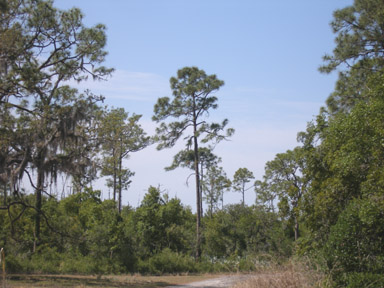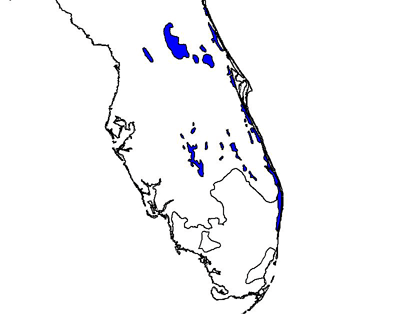
Slash pine (Pinus elliottii), Archbold Biological Station, central Florida (c) 2008 Kari Segraves
Bioimages home (click on an image to enlarge)
view
this page in its intended navigation context
Florida Sand Pine Scrub
(WWF
ecoregion NA0513)

Slash pine (Pinus
elliottii), Archbold Biological Station, central Florida
(c) 2008 Kari Segraves

Source of bioregions data:
Olson, D. M. and
E. Dinerstein. The Global 200: Priority ecoregions for global conservation. (PDF
file) Annals of the Missouri Botanical Garden 89:125-126.
Distinctiveness (1=highest,4=lowest): 1
(globally outstanding)
This is Florida's most distinctive habitat with about half of the species
endemic to the ecoregion. Species must be able to survive in the dry,
sandy environment. *
Conservation Status (1=most endangered, 5=most
intact): 1 (critical)
The ecoregion itself is very small and only about 10 percent remains intact.
Urbanization and the development of citrus groves is responsible for much of the
loss and fire suppression results in the conversion to other habitat types.*
 Pinus
clausa (scrub pine)
(c) 2008 Kari Segraves
Pinus
clausa (scrub pine)
(c) 2008 Kari Segraves Quercus
myrtifolia (myrtle oak)
(c) 2008 Kari Segraves
Quercus
myrtifolia (myrtle oak)
(c) 2008 Kari Segraves Aphelocoma
coerulescens (Florida scrub jay)
(c) 2008 Kari Segraves
Aphelocoma
coerulescens (Florida scrub jay)
(c) 2008 Kari Segraves
 Gopherus
polyphemus (Gopher Tortoise)
(c) 2008 Kari
Segraves
Gopherus
polyphemus (Gopher Tortoise)
(c) 2008 Kari
Segraves
Associated habitats
Fire-adapted longleaf pine-palmetto forest, Archbold Biological Station, central Florida

Pinus palustris (longleaf pine) and
Serenoa repens
(saw palmetto)
(c) 2008 Kari Segraves
hires
* Ricketts, T.H., E. Dinerstein, D.M. Olson, C.J. Loucks, et al. (1999) Terrestrial Ecoregions of North America: A Conservation Assessment. World Wildlife Fund - United States and Canada. Island Press, Washington, D.C. pp. 268-271.